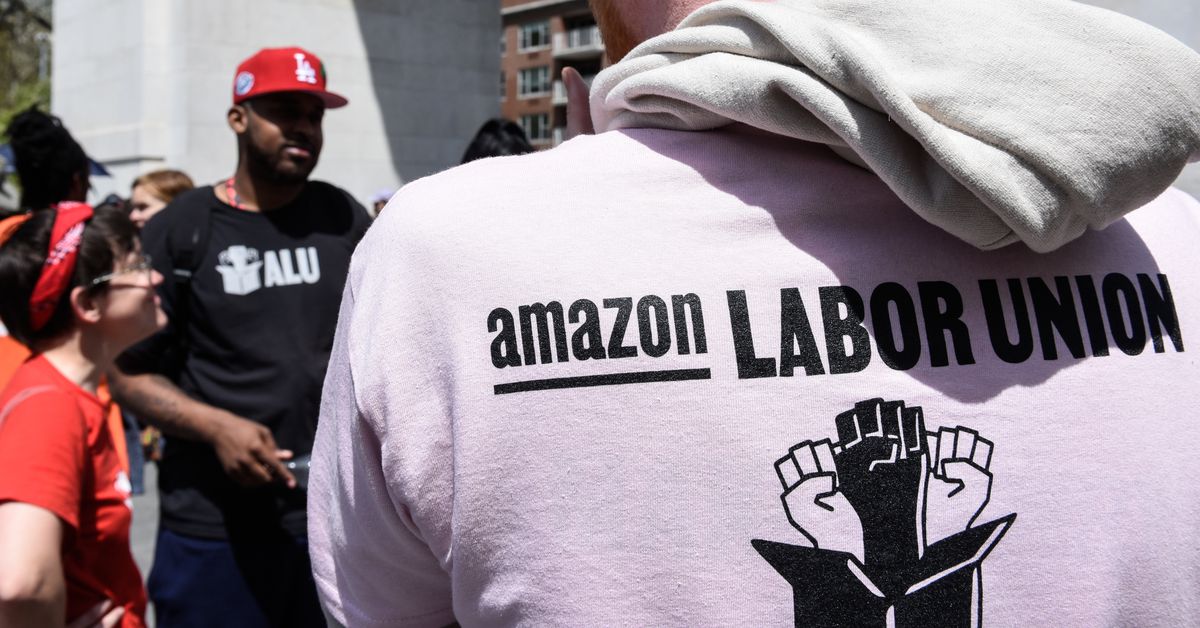Amazon’s worker union just lost in New York City. Where does it go from here?
Amazon workers participate in a May Day rally in Manhattan a day before a worker union lost an election at a second New York City warehouse. | Stephanie Keith/Getty ImagesThe loss at an Amazon sort center in Staten Island...

A month after a new union started by Amazon warehouse workers became the first to win a US election in the company’s history, workers at a nearby Amazon facility voted against unionizing with the same grassroots organization.
Workers at an Amazon package sort center, known as LDJ5, voted 618 to 380 against unionizing with the Amazon Labor Union (ALU), a union founded last year by fired Amazon worker Chris Smalls and several colleagues. A victory at LDJ5 would have given the union the right to negotiate a collective bargaining agreement with Amazon at two key warehouses that play separate but complementary roles in serving Amazon customers in the critical New York City metropolitan area. That combination could have given organizers more leverage in contract negotiations with Amazon, but that advantage looks gone for now.
“We’re glad that our team at LDJ5 were able to have their voices heard,” Kelly Nantel, an Amazon spokesperson, said in a statement. “We look forward to continuing to work directly together as we strive to make every day better for our employees.”
On Twitter, ALU founder Chris Smalls said, “Despite todays outcome I’m proud of the worker/organizers of LDJ5. [T]hey had a tougher challenge after our victory at JFK8.”
He added that his union “will continue to organize and so should all of you.”
The loss comes a month after the historic election at a larger nearby Amazon fulfillment center called JFK8. There, the union captured 2,654 votes, while 2,131 voted against organizing. (Workers at Amazon fulfillment centers like JFK8 pick, stow, and pack customer merchandise to the tune of 300 to 400 items an hour, while workers at sort centers like LDJ5 typically sort already-packaged orders by geographic destination.) Amazon is seeking to throw out the results, arguing that both the union and the National Labor Relations Board (NLRB), which oversaw the election, acted inappropriately. The NLRB has scheduled a May 23 hearing to discuss Amazon’s objections.
Separately, Amazon is still dealing with an organizing attempt by a separate union, the Retail, Wholesale and Department Store Union, in Bessemer, Alabama. Votes were tallied in late March for a re-do election at the Alabama warehouse called BHM1, after an NLRB official ruled that Amazon illegally interfered with the first election at the facility in 2021. The union is currently trailing by a little more than 100 votes in Bessemer, but the outcome is still up in the air because Amazon and the union contested more than 400 additional ballots combined. Those need to be scrutinized at a future hearing — and potentially counted — before a final result is confirmed in the coming months. In the first overturned Bessemer vote in 2021, workers had voted overwhelmingly in Amazon’s favor.
Whether a win or a loss at LDJ5, ALU was going to have an uphill battle, even if the original JFK8 election victory is upheld. Large anti-union employers like Amazon typically try to stall contract negotiations in the hopes the organizers or workers will lose interest, especially in a workplace like an Amazon warehouse where annual turnover rates have surpassed 100 percent. If a year passes after a finalized union election victory without a collective bargaining agreement, a decertification vote can take place.
“It’ll be a big challenge to get that first contract in a reasonable amount of time, and the workers will need to continue organizing, continue to fight, and possibly take job actions in order to win that first contract,” Rebecca Givan, a Rutgers University labor professor, told Recode.
This loss may make that JFK8 contract even harder to attain.
Depending on your point of view, the loss at LDJ5 could suggest that ALU was only able to win at JFK8 because the worker-leaders personally knew many of the associates in the building and will struggle to organize any other Amazon warehouses. Amazon operates more than 800 warehouse facilities of different sizes across the US. Some might also see the defeat as a sign that ALU, with only a sliver of the resources of large established unions, tried to bite off more than it could chew.
On the other hand, this week’s loss could be interpreted as a simple manifestation of the deck being stacked too heavily against ALU. The LDJ5 sort center workforce consists of a greater percentage of part-time workers than JFK8 — which typically makes organizing harder — and Amazon spent aggressively to make sure it doesn’t end up on the wrong side of history in a second straight union election. (Amazon spent more than $4 million on anti-union consultants in 2021 alone.) Amazon sort center roles also have a reputation among workers for being less stressful than some of the main roles at a larger fulfillment center like JFK8.
Givan, the Rutgers professor, said she did not agree with those who might call the first victory a fluke in the wake of a loss at the second location.
“People who don’t have a particular understanding of the broken NLRB process think that an election outcome is the result of a free and fair election where workers just said whether or not they wanted to unionize and that there is no undue influence or pressure,” Givan said. “In reality, it’s a demonstration of … the successful fear-mongering of the anti-union campaign.”
In the union drive at the larger JFK8 facility, the union said it wanted to push Amazon leadership for large hourly raises, longer breaks for workers, and union representation during all disciplinary meetings to prevent unjust firings that may exacerbate already-high staff turnover. At the smaller LDJ5 sort center, organizers said one key motivation to unionize was Amazon’s unwillingness to provide workers with enough hours to make ends meet.
Work hours are “not based on what workers want or the workers need,” a union organizer and LDJ5 employee recently told the New York Times. “It’s based off of what Amazon has figured out to be most efficient at the expense of the workers.”
Still, even before the loss at LDJ5 — or the victory at JFK8, for that matter — the pressure from the first pandemic-era union drive at the Bessemer, Alabama, warehouse seemed to have forced Jeff Bezos to reconsider the company’s treatment of its workforce. In his final shareholder letter as CEO in 2021, he said his company needs “to do a better job for our employees.” In the same letter, Bezos announced a new mission for his company: “Earth’s Best Employer and Earth’s Safest Place to Work.”
Then came the win at JFK8 despite Amazon’s long history of union-busting in the 28 years since Jeff Bezos founded the company in 1994 as an online seller of books. But on Monday, the latest inflection point in the internal labor battle went Amazon’s way.
Update, May 2, 3:40 pm ET: This story has been updated to include statements from Amazon and ALU organizer Chris Smalls.

 Aliver
Aliver 






























